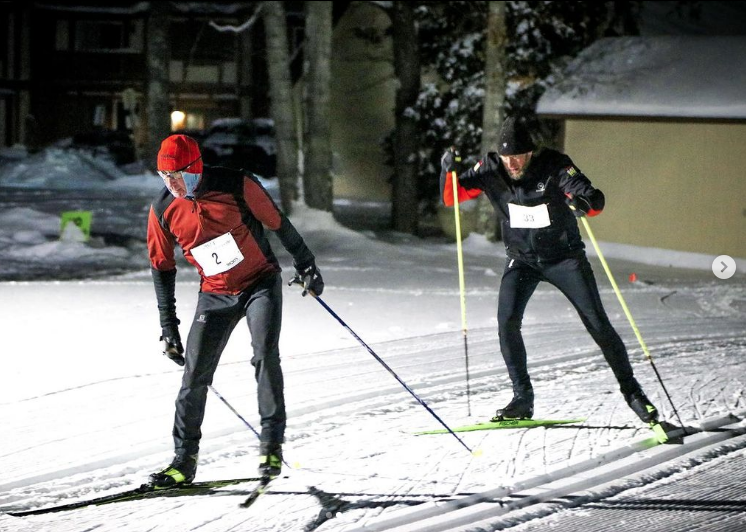
Crazy, Hard, and Worth It
Wed, Jan 3, 2024 - By Mariah Frye Colie
Why the most challenging ski races often are the most memorable, and why we shouldn’t avoid them.
It was 4:45am. I waited, car running, outside my brother’s house. The thermometer read -2F. I sipped my coffee, chased it with water, and double checked my Google map. In two hours, we’d be at the starting line of the most grueling ski race on the Michigan Cup race schedule last season: the modified White Pine Stampede, a 10.5km slog up, down and around the slopes of Shanty Creek downhill ski resort.
Every ski racer has likely had the thought, “why did I sign up for this?” at least once. The truth is, we’re excited when we sign up, because we imagine the glorious feeling of finishing it. We picture the destination, the finish line. But once the race gets closer, the fuller picture of what it will unavoidably take to cross that finish line becomes more glaring. Sometimes, what it will take is within our comfort zone: we’re in shape and healthy, the weather forecast is favorable, waxing will be straightforward, snow conditions are good -you get the picture. We tend to look forward to these kinds of races, because so much is in our favor. We might even describe them as “fun”!
And then sometimes, like on this particular morning, none of this is the case. The windchill at the start of the race was -6F, and the frigid, man-made snow glided about as well as sandpaper. My Salomons felt slow, my Fischers felt slower. And, almost like an insult, the race started at 7:00am, well before sunrise; the snow surface was lit only by floodlights from the chairlifts.

The race was set up as 3-laps around a 3.5km loop that wove, snake-like, up and down the runs of Schuss Mountain. The first uphill felt comical, because it was so very long and steep. But the joke soon wore off when I realized just how challenging it was to ski up these Blue Square runs, which seemed to go straight up and last lifetimes. Contrary to most races, the downhills were not a chance to rest; they were perilous and unforgiving, requiring just as much physical output as the uphills, and far more mental energy. There were no flats, no moments of respite. And, we’d have to do it all again, twice. “Why did I sign up for this?” was soon substituted by “Oh. My. God. Help me.”
The classic skiers herringboned endlessly alongside the skate skiers, most of them (myself included) just barely able to keep their “V1” climbing form, and ultimately resorting to “single-sticking” it up every single hill. At one section, the light from the lift lights failed to reach the course, causing us to ski through a ~200 yard stretch in almost complete, exhilarating darkness. In over 10 years of racing, I have never seriously considered quitting a ski race before, but in those first few climbs, I was mentally mapping out how I would escape to my car.
Amidst the literal mountains of adversity, though, there started to appear a silver lining. By the third lap, dawn was approaching and the sky was lightening. As our bodies warmed and our expectations of a “good time” had completely bottomed out, it was actually getting a little easier to come to terms with this excruciating experience. Throughout the race, as I looked around through frosted eyelashes at all of these people dressed in Lycra, doing this incredibly hard thing, it really did seem like mass insanity. (Who knows, maybe that still applies?) However, after we finished the race, I noticed that most of these people were… Smiling? Laughing? Hugging each other, patting backs, high fiving?! The stories were incredible. Falling and rolling, not once, not twice, but all three times down the last, treacherous run; reaching obscene speeds on Strava; finding out that each hill you had to climb was taller than the last one. Everyone’s eyes were huge with shock that we not only showed up to do this event - something so seemingly arbitrary in the scheme of life - but that it was wildly more difficult than we thought it would be. But our hearts were even bigger, because WE DID IT. We all grew that day individually, and collectively. All the skiers there that day now have a special bond, a hard-fought feather in their caps that no one can take away.
The fair weather races are fun. It’s true. We should do the fair weather races and revel in the ecstatic experience. And, we should do the foul weather races. Because if all the races were fair weather races, racing wouldn’t be as rewarding. Sebastian Junger says, “Humans don’t mind hardship, in fact they thrive on it; what they mind is not feeling necessary.” Let us not forget that in showing up, we are showing up not just for ourselves, but for everyone else, too. It is during these hard times that our presence is truly necessary; necessary to the community, the comrades, the collective. When we do hard things together, we experience our own humanity and the humanity of others in a truly meaningful and powerful way; a way that stays with us and, I would argue, makes the world a better place.

